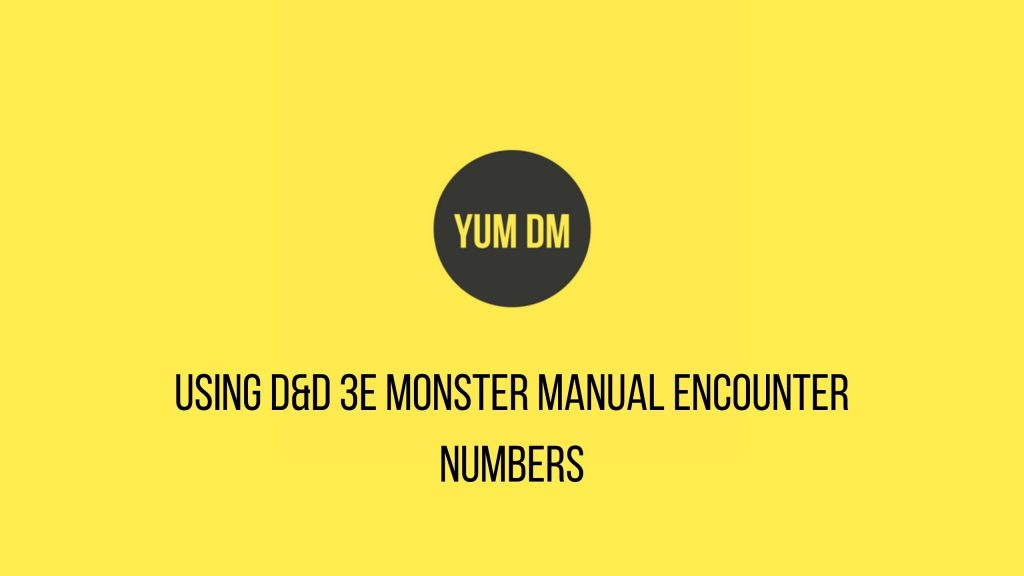
One of the great things about the Dungeons And Dragons 3rd edition Monster Manual is the additional information they give you regarding monsters.
This includes the climate and terrain the monsters are found in, and their organisation (numbers appearing).
This blog post will focus on the latter.
Instead of using one number for number appearing like in earlier editions, 3e provides varying groups based on the creature.
For example, orcs can can appear as a gang (2-4 appearing), squad (11-20, plus leaders), or a band (30-100 plus non-combatants and leaders).
While Medusas appear solidary or in a covey (2-4).
Why Use Encounter Numbers?
This not only gives you variety when making up your random encounter tables, but it provides some great inspiration as well.
For more on random encounters, see my article on what the monsters are doing and Issue 7 of my D&D zine (page 16) where I discuss random enounters and show you how to build your own.
You can integrate these varying encounter numbers into your encounter tables.
Encounter tables always have number of creatures appearing and while most of these are level-appropriate, they don’t need to be.
If the party runs into a group of orc, the encounter could be very different if they run into a gang or a band!
The first one, the PCs could easily dispatch, while the second, the PCs are more likely to try and hide or run and can then decide how (if at all) they tackle 30-100 orcs!
The GM can also have fun coming up with reasons why so many orcs are on the move.
Maybe it’s an army marching on a town (will the PCs warn the town? And can they get there before the orc army?), or a displaced village of orcs who are looking for a new place to settle (this could allow some interesting roleplay moments).
This means your world will feel much more real to the players and will add some more excitement into the game, rather than just killing level-appropriate monsters.
How to Use Encounter Numbers
You can use these varying encounter numbers to make your encounter tables much more realistic and dynamic.
When a certain creature is rolled on a random encounter table, you can quickly roll a simple D6 to determine their numbers.
Let’s look at the two examples from above.
With the orcs, the table could look like this:
Roll Result
1-4 Gang
5 Squad
6 Band
While the Medusa would be:
Roll Result
1-5 Solitary
6 Covey
Altering the Tables
You could also change this depending on climate or location in general.
If you are in a known orc-infested area of your campaign world, you could alter the table to favour the squad or band as these would be more likely.
If, on the other hand, the PCs are exploring some ancient ruins, a covey of medusas would be more likely than represented in the table above. Maybe 1-3 on a D6.
On the other hand, the PCs are more likely to encounter Pseudodragons in temperate or warm forests, so it makes sense their numbers may be greater in these areas (a clutch of 3-5).
You could create these tables beforehand, when creating the encounter table, or simply decide at the time – “winging it”.
D6 tables are quite easy to create and won’t take much time at all – whether you do it beforehand or at the table.
Or, you could use the D6 Mechanic to decide based on various odds.
Over to You
How would you use these encounter groupings?
While You’re Here…
Since 2021 I have been publishing a monthly zine, which has a ton of articles for any edition of Dungeons & Dragons.
They are also available on DriveThruRPG and printed copies are available via my Patreon.
I also have a growing Discord, where you can join in on my regular West Marches campaign.
I will also be releasing some more products in the near future, like several monster manuals and a series of soloRPG publications.
Feel free to reach out to me on Twitter any time.
While You’re Here…
Since 2021 I have been publishing d12 Monthly, a monthly zine, which has a ton of articles for any edition of Dungeons and Dragons.
Printed copies are available in my store. The PDF is available on DriveThruRPG and you can get both, plus support my work, via my Patreon.
I will also be releasing some more products in the near future.
Feel free to reach out to me on Twitter or my contact page any time.

Love learning a new word definition – thanks, Russ!
No worries. Most of the words I know have come from playing D&D. 🙂
This adds a more nuanced approach to random encounters, which will make it more enjoyable for the players, and that can only be a good thing.
And it does not add much more overhead in planning your encounters. I did a small test with some Aspis from A1
Aspis are Insect like creatures
Within that creature group you could have Drones, Larvae or a Cow (queen)
So on a D6
1-3 Aspis Patrol (no more than 10 as per the wandering monster table in the module)
4 – Aspis on the move (2-20)
5 – Roaming Voraciously Hungry Larvae (3-30)
6- The Cow (Queen in search of a new nest with Drone support and a few Larvae in tow)
This is cool. A nice practical application of the system. Good job!
While the Medusa would be:
Roll Result
1-5 Solitary
6 Covey <= should this be Coven?
I was thinking about 3E the other day – going to have to break out some of the books again…
Awesome. I am always looking through my 3rd edition books – a lot of gold there.
Covey means: a small group of people or things. So it fits. Coven is more a witches thing, I think.